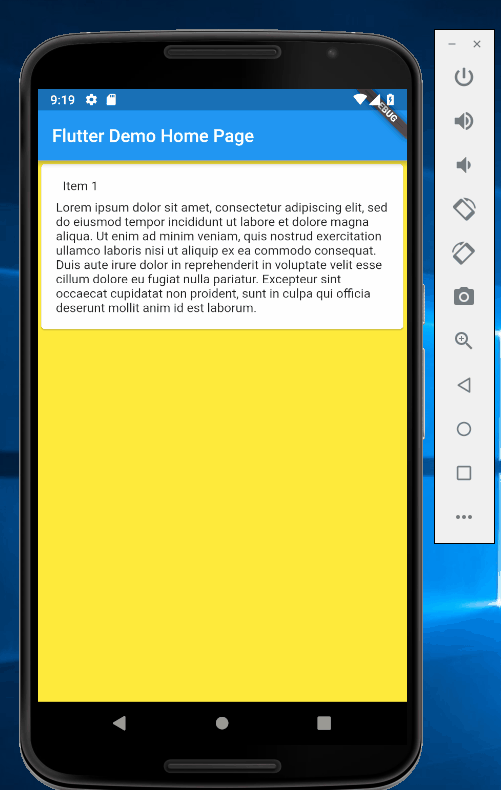Flutter ListView lazy loading
Solution 1:
You can listen to a ScrollController.
ScrollController has some useful information, such as the scrolloffset and a list of ScrollPosition.
In your case the interesting part is in controller.position which is the currently visible ScrollPosition. Which represents a segment of the scrollable.
ScrollPosition contains informations about it's position inside the scrollable. Such as extentBefore and extentAfter. Or it's size, with extentInside.
Considering this, you could trigger a server call based on extentAfter which represents the remaining scroll space available.
Here's an basic example using what I said.
class MyHome extends StatefulWidget {
@override
_MyHomeState createState() => _MyHomeState();
}
class _MyHomeState extends State<MyHome> {
ScrollController controller;
List<String> items = List.generate(100, (index) => 'Hello $index');
@override
void initState() {
super.initState();
controller = ScrollController()..addListener(_scrollListener);
}
@override
void dispose() {
controller.removeListener(_scrollListener);
super.dispose();
}
@override
Widget build(BuildContext context) {
return Scaffold(
body: Scrollbar(
child: ListView.builder(
controller: controller,
itemBuilder: (context, index) {
return Text(items[index]);
},
itemCount: items.length,
),
),
);
}
void _scrollListener() {
print(controller.position.extentAfter);
if (controller.position.extentAfter < 500) {
setState(() {
items.addAll(List.generate(42, (index) => 'Inserted $index'));
});
}
}
}
You can clearly see that when reaching the end of the scroll, it scrollbar expends due to having loaded more items.
Solution 2:
Thanks for Rémi Rousselet's approach, but it does not solve all the problem. Especially when the ListView has scrolled to the bottom, it still calls the scrollListener a couple of times. The improved approach is to combine Notification Listener with Remi's approach. Here is my solution:
bool _handleScrollNotification(ScrollNotification notification) {
if (notification is ScrollEndNotification) {
if (_controller.position.extentAfter == 0) {
loadMore();
}
}
return false;
}
@override
Widget build(BuildContext context) {
final Widget gridWithScrollNotification = NotificationListener<
ScrollNotification>(
onNotification: _handleScrollNotification,
child: GridView.count(
controller: _controller,
padding: EdgeInsets.all(4.0),
// Create a grid with 2 columns. If you change the scrollDirection to
// horizontal, this would produce 2 rows.
crossAxisCount: 2,
crossAxisSpacing: 2.0,
mainAxisSpacing: 2.0,
// Generate 100 Widgets that display their index in the List
children: _documents.map((doc) {
return GridPhotoItem(
doc: doc,
);
}).toList()));
return new Scaffold(
key: _scaffoldKey,
body: RefreshIndicator(
onRefresh: _handleRefresh, child: gridWithScrollNotification));
}
Solution 3:
The solution use ScrollController and I saw comments mentioned about page.
I would like to share my finding about package incrementally_loading_listview
https://github.com/MaikuB/incrementally_loading_listview.
As packaged said : This could be used to load paginated data received from API requests.
Basically, when ListView build last item and that means user has scrolled down to the bottom.
Hope it can help someone who have similar questions.
For purpose of demo, I have changed example to let a page only include one item
and add an CircularProgressIndicator.

...
bool _loadingMore;
bool _hasMoreItems;
int _maxItems = 30;
int _numItemsPage = 1;
...
_hasMoreItems = items.length < _maxItems;
...
return IncrementallyLoadingListView(
hasMore: () => _hasMoreItems,
itemCount: () => items.length,
loadMore: () async {
// can shorten to "loadMore: _loadMoreItems" but this syntax is used to demonstrate that
// functions with parameters can also be invoked if needed
await _loadMoreItems();
},
onLoadMore: () {
setState(() {
_loadingMore = true;
});
},
onLoadMoreFinished: () {
setState(() {
_loadingMore = false;
});
},
loadMoreOffsetFromBottom: 0,
itemBuilder: (context, index) {
final item = items[index];
if ((_loadingMore ?? false) && index == items.length - 1) {
return Column(
children: <Widget>[
ItemCard(item: item),
Card(
child: Padding(
padding: const EdgeInsets.all(16.0),
child: Column(
children: <Widget>[
Row(
crossAxisAlignment:
CrossAxisAlignment.start,
children: <Widget>[
Container(
width: 60.0,
height: 60.0,
color: Colors.grey,
),
Padding(
padding: const EdgeInsets.fromLTRB(
8.0, 0.0, 0.0, 0.0),
child: Container(
color: Colors.grey,
child: Text(
item.name,
style: TextStyle(
color: Colors.transparent),
),
),
)
],
),
Padding(
padding: const EdgeInsets.fromLTRB(
0.0, 8.0, 0.0, 0.0),
child: Container(
color: Colors.grey,
child: Text(
item.message,
style: TextStyle(
color: Colors.transparent),
),
),
)
],
),
),
),
Center(child: CircularProgressIndicator())
],
);
}
return ItemCard(item: item);
},
);
full example https://github.com/MaikuB/incrementally_loading_listview/blob/master/example/lib/main.dart
Package use ListView index = last item and loadMoreOffsetFromBottom to detect when to load more.
itemBuilder: (itemBuilderContext, index) {
if (!_loadingMore &&
index ==
widget.itemCount() -
widget.loadMoreOffsetFromBottom -
1 &&
widget.hasMore()) {
_loadingMore = true;
_loadingMoreSubject.add(true);
}
Solution 4:
here is my approach which is inspired by answers above,
NotificationListener(onNotification: _onScrollNotification, child: GridView.builder())
bool _onScrollNotification(ScrollNotification notification) {
if (notification is ScrollEndNotification) {
final before = notification.metrics.extentBefore;
final max = notification.metrics.maxScrollExtent;
if (before == max) {
// load next page
// code here will be called only if scrolled to the very bottom
}
}
return false;
}
Solution 5:
here is my solution for find end of listView
_scrollController.addListener(scrollListenerMilli);
if (_scrollController.position.pixels == _scrollController.position.maxScrollExtent) {
getMoreData();
}
If you want to lazy load after 1/2 or 3/4, change like this.
if (_scrollController.position.pixels == (_scrollController.position.maxScrollExtent * .75)) {//.5
getMoreData();
}